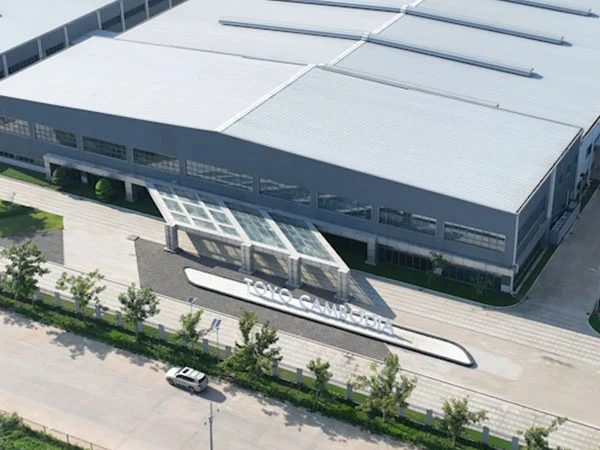Building Use:Making Christmas Lights
Area:90000㎡
Steel Usage:3000t
Factory Structure and Project Features: Portal Steel Frame

In the demanding world of power generation and distribution, reliability and durability are paramount. At HCGG, we are a leading steel structure manufacturer specializing in the design, fabrication, and installation of advanced steel solutions for the electrical industry. Our expertise ensures the foundation of your operations is strong, safe, and built to last.
A Steel Structure Electrical Factory is an industrial building designed for the manufacturing, assembly, or testing of electrical and electronic components, where the primary load-bearing system is made from structural steel.
This combination is extremely popular because the characteristics of steel structures are uniquely suited to the demands of the electrical industry.
Large Clear Spans: Steel's high strength-to-weight ratio allows for the creation of vast, open interior spaces without many interrupting support columns. This is critical for:
Flexible Assembly Lines: Easy layout and reconfiguration of production lines.
Large Equipment: Accommodating bulky machinery like transformers, generators, and automated manufacturing systems.
Material Handling: Unobstructed paths for forklifts, overhead cranes, and robotic transport.
High Strength & Load-Bearing Capacity:
Overhead Cranes: Steel frames are easily designed to support heavy-duty overhead crane runway beams, essential for moving large components like transformer cores, switchgear, and heavy coils.
Heavy Machinery: The structure can handle significant point loads from heavy machinery installed on the factory floor or on mezzanine levels.
Speed of Construction:
Prefabrication: Steel components (columns, beams, trusses) are manufactured off-site in a controlled environment.
Fast Erection: These prefabricated parts are then transported to the site and bolted together, significantly reducing on-site construction time compared to concrete.
This means the factory can become operational much faster.
Design Flexibility & Future Expansion:
Steel structures can be easily modified, reinforced, or extended. If the factory needs to expand its production line or add a new wing, it's relatively simple to bolt on new sections to the existing frame.
Durability and Low Maintenance:
Steel is resistant to pests, rot, and fire (when properly fire-proofed). With modern coatings like galvanization or specialized paints, it is also highly resistant to corrosion, leading to a long service life with minimal maintenance.
Cost-Effectiveness:
While raw material costs fluctuate, the overall project cost is often lower due to reduced labor time on-site, faster construction, and lighter foundation requirements (as steel is lighter than concrete).
Sustainability:
Steel is one of the most recycled materials in the world. Using a steel structure often contributes to a building's green credentials (e.g., LEED certification).
Building an electrical factory with a steel structure requires addressing specific operational needs:
Floor Loading & Foundations:
The concrete slab-on-grade floor must be designed for heavy, and sometimes vibrating, machinery.
Special foundations or thickened slabs are needed directly under heavy equipment like presses, winding machines, or testing bays.
Overhead Crane Integration:
The main steel columns must be designed with corbels (brackets) to support the crane runway beams.
The entire frame, including bracing, must be engineered to handle the dynamic loads (acceleration, braking, and lifting) from the crane.
Specialized Environments (Clean Rooms):
For manufacturing sensitive electronics (e.g., semiconductors, PCBs), the steel structure must accommodate the construction of clean rooms. This involves integrating complex HVAC systems, airlocks, and using wall/ceiling panels that do not shed particles.
Fire Safety:
This is critically important. While steel is non-combustible, it loses its strength at high temperatures.
Fireproofing: Structural steel columns and beams must be protected with fire-resistant coatings like intumescent paint (which expands when heated to form an insulating char), spray-on fire-resistant materials (SFRM), or by being encased in fire-rated board or concrete.
Firewalls: The steel frame is designed to incorporate fire-rated separation walls between high-risk areas (e.g., transformer oil storage, testing labs) and the main production floor.
Electrical Infrastructure & Grounding:
The design must include extensive support systems for cable trays, busbars, and conduits. These can be easily attached to the steel purlins and beams.
The steel frame itself is an excellent electrical conductor and is typically integrated into the building's lightning protection and grounding (earthing) system to ensure personnel safety and protect sensitive equipment.
Ventilation and Climate Control:
Electrical manufacturing and testing can generate significant heat. The building envelope (roof and wall cladding) must be well-insulated.
The steel structure must be designed to support large roof-mounted HVAC units, exhaust fans, and louvers for effective ventilation.
Mezzanines and Office Spaces:
It is common to integrate multi-level office blocks or control rooms within the larger factory hall. Steel-framed mezzanines are a lightweight, strong, and fast way to create this additional space.

Create the greatest value for customers
Provide the best quality products and services
+8618800767079
info@hcggsteel.com
No.1 Shuangxiang Road, Luoxin Industrial Park, Luoyang City